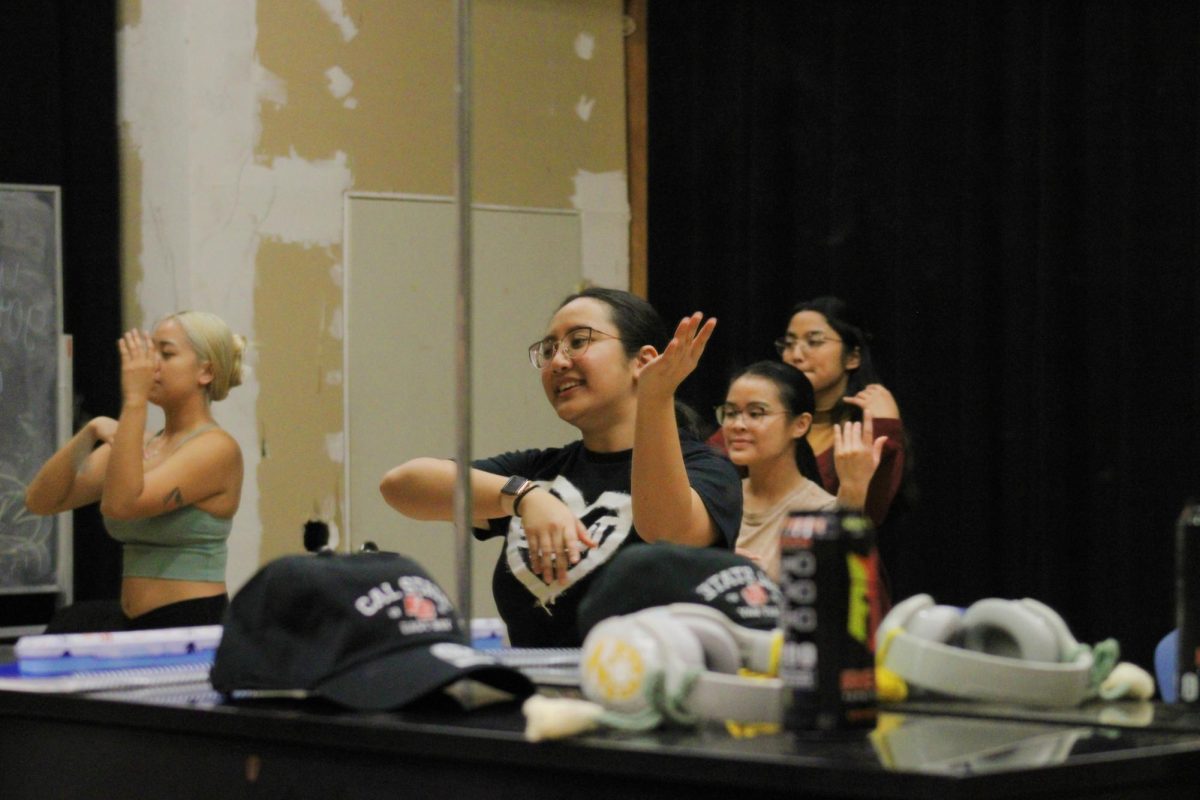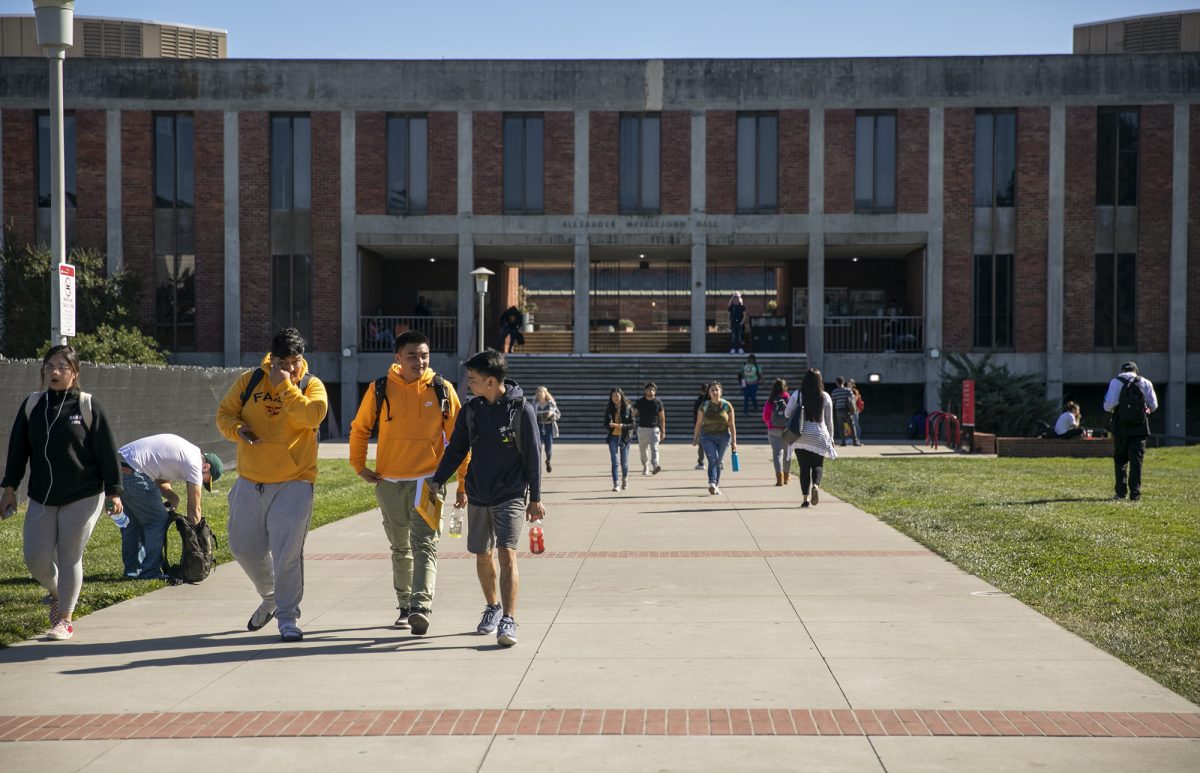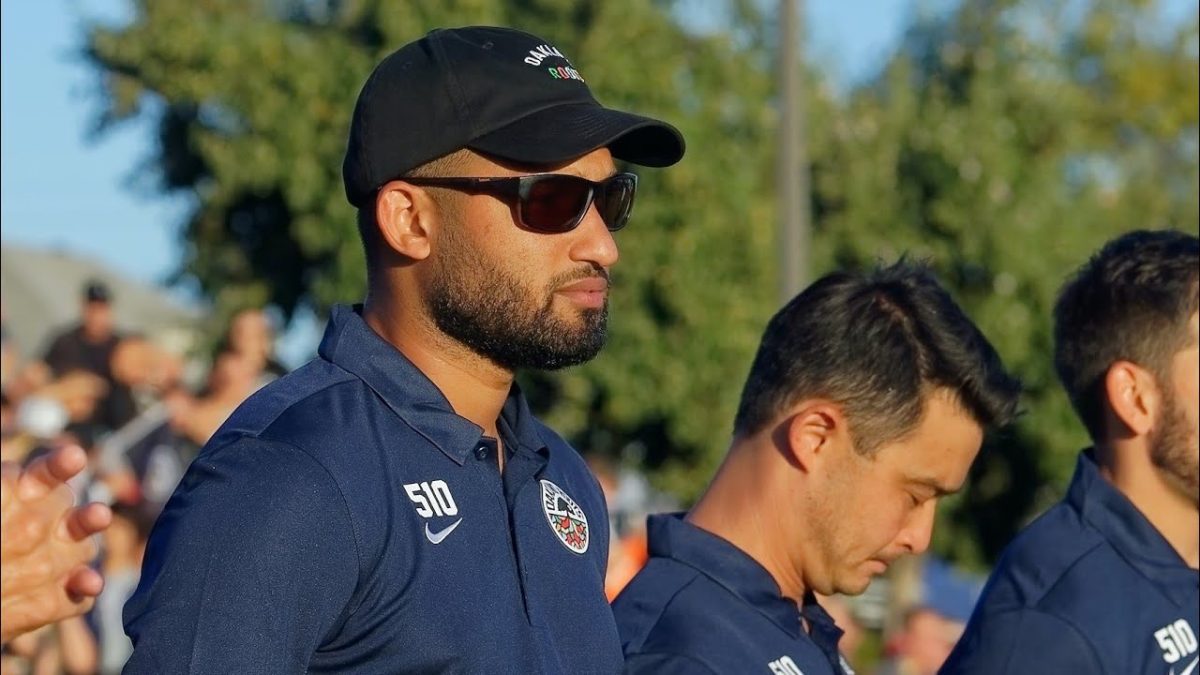CSU East Bay students often wonder if the college has a football team. Some argue that is a big part of what they wish to include as part of their college experience. A campus that has a football team often has a distinct community and school pride that bonds and electrifies the student body. This vision coincides with efforts by the city of Hayward to transform itself into a “college town.”Implementing a football program at CSUEB could make the campus and the city of Hayward a vibrant destination.“I hear from the people that do campus tours that one of the top three questions that gets asked is do we have a football team,” said former Director of Athletics Debby De Angelis in an interview. “Now I kind of get it, we have this beautiful stadium here, it’s been modified so right now it doesn’t work to play football, but what gets modified could be changed.” Despite a glimmer of hope in De Angelis’ statement, sports advocates point out that there hasn’t been a battle on the gridiron since 1993 due to budget restrictions and Title IX implications, which mandates gender equality in college athletics. CSUEB currently has six men’s sports teams and nine women’s sports teams active in the athletic department. “We have fifteen sports here which is a big commitment and provides a much broader range of engagement than other campuses,” said CSUEB’s Chief Financial Officer Brad Wells. Still, at a recent meeting with a CSUEB class on policy guidelines for the future, Hayward City Senior Planner Sara Buizer noted that transforming the city into a “college town” is one of the points of emphasis in the “Looking Forward 2040” policy guidelines to improve Hayward. One of the topics brought up in Buizer’s discussion was whether or not CSUEB implementing a football team would help in this directed effort. Buizer discussed that the future of Hayward could benefit from having a football team, as it would enhance the community participation and reputation. The discussion touched on the possibility that with community support the dream to implement a football team at CSUEB could be possible. Some former CSUEB football players already support the university’s athletics. “I run into football alums all the time. One of our alumni association board members played football here, so those guys are around and still very supportive of the university because of the positive experience they had playing football here at CSU East Bay,” said De Angelis. For nearly two decades, CSUEB has been challenged with meeting the needs of proportionality in their athletic department. Like the other 23 campuses in the CSU system, CSUEB agreed with the National Organization for Women stipulations for Title IX and dropped football mainly because of the expenses of travel, scholarships, and supporting a roster of more than 100 men. Proportionality limitations tie into Title IX, a law originally passed in 1972, as it requires gender equality for men and women in every educational program that receives federal funding. This measure has made way for women to join sports organizations on campuses that in turn have led to opening up doors in the professional sports world. However, the other side of the token reveals that there are some implications to having a gender equality restrictions as big sports have been cut out due to proportionality needs. “Football here at East Bay, as most places, is a very expensive sport with a large squad and high facility demands. One of the implications of Title IX requires proportionality. On this campus, 60 percent of the student body is female and 40 percent male, so it’s a bit of a challenge to make sure that proportionality is met. The trade offs for football are significant, the number of sports that we would need to add or retain in women’s fields to off set the costs of football or the number of men’s sports to eliminate and provide football would be really unsustainable,” said Chief Financial Officer Brad Wells.To add a football program, CSUEB has a few options. The first is community drive. If community members, alumni, and other supporters coordinate to create a fundraising effort there could be hope to reestablish football on the Pioneer campus, sports sources explained. The funds needed would be steep; as it needs to be enough to cover the costs of a football program as well as the amount it would take to add more women’s sports in order to balance out the proportionality. “First of all nobody has come up with enough money to really make it happen or it would probably have happened. Partly because enough money isn’t just enough money for football but also for the traveling to Washington and Oregon, as well as all the other opportunities for women,” said De Angelis. “I’ve definitely had people say that they’re willing to fundraise for it, one or two in twelve years not a whole lot of people. But people do talk about it.”A second option to lessen the costs would be to cut one or more of men’s sports that are currently active at CSUEB. However, De Angelis says, “At this point I don’t have a men’s sport that I would ever be willingly to give up. They’re all doing well.”Aside from the funds, another big problem CSUEB faces is having no competition to go up against as there’s only one other division two football team in the whole state of California and that’s CSU Humboldt.Humboldt is the one CSU that leads the way in its ability to maintain a college team in Division II. This small community in the North West corner of California has kept football running successfully with the backing of student and community support. De Angelis described the Humboldt student campus body as a very active fan base.“They sell out their basketball games, it’s what their students do on Saturday afternoon,” said De Angelis. Humboldt added women’s soccer and rowing program to balance out the costs of the football department instead of just merely cutting it out as all other CSU’s did. “Because Humboldt’s community was so strongly supportive and they’re proportional mix is different then ours, they have unique circumstances and a more equally balanced population making it less of an issue to deal with,” said Wells.Not including scholarships, Humboldt spends slightly more than $650,000 a year on football according to the New York Times article “Humboldt State, Revved Up for Success” written on September 11, 2012. The program is financed through student fees and private money. With limited funding coming for the football program, Humboldt offers far fewer than the 36 scholarships that the N.C.A.A allows for Division II universities according to the New York Times. The program attempts to cut down costs where ever they can, doing this by taking long bus trips to road games and having students work to maintenance the stadium. The community of Humboldt and the student body are very engaged in not just the football games but all athletic events on campus which gives it the support it needs to continue into the future despite the always wavering state of California’s budget.While CSUEB has been coined a “commuter campus,” by most students, it doesn’t rule out implementing a football program. With the city of Hayward planning and creating policies to make the community more of a “college town” there is hope that perhaps East Bay too can one day have a football team again, sports sources said. In the Hayward General Plan “Looking Forward 2040,” created by the City Planning Commission in March of this year, one of their guiding principles and visions is to be known as one of the best college towns in the West. Hayward recognizes the lack of engagement between its community and university “In general, most students do not have a strong connection to the Hayward community,” as well as, “promote events and festivals that foster college culture and a sense of college and community pride.” One idea is to implementing a football team at CSUEB which would bring a positive college vibe and community engagement that the city of Hayward is chasing after. It would foster the type of culture a college town needs. While CSUEB’s general attitude towards adding a football program is that the costs would be way too high and the consequences would be too dramatic, nothing is unattainable.Perhaps with the backing of the Hayward community and the support of students, fundraisers can be used to navigate towards re-implementing a football program here at CSUEB. Looking at Humboldt’s actions as a guide and example, the CSUEB campus along with the community of Hayward can replicate their success if it is indeed something they both truly want. “I think that having a football team at East Bay would bring in a big crowd,” said CSUEB student Kyle Podany. “[It] would be a good thing for the future of both Hayward and the university.”
A Glimpse into CSUEB’s Take on Implementing a Football Program
Leanne Cozart
Contributor • 19 Views
Contributor • 19 Views
June 6, 2013
CSU East Bay students often wonder if the college has a football team. Some argue that is a big part of what they wish to include as part of their college experience. A campus that has a football team often has a distinct community and school pride that bonds and electrifies the student body. This vision coincides with efforts by the city of Hayward to transform itself into a “college town.”
Implementing a football program at CSUEB could make the campus and the city of Hayward a vibrant destination.
“I hear from the people that do campus tours that one of the top three questions that gets asked is do we have a football team,” said former Director of Athletics Debby De Angelis in an interview. “Now I kind of get it, we have this beautiful stadium here, it’s been modified so right now it doesn’t work to play football, but what gets modified could be changed.”
Despite a glimmer of hope in De Angelis’ statement, sports advocates point out that there hasn’t been a battle on the gridiron since 1993 due to budget restrictions and Title IX implications, which mandates gender equality in college athletics. CSUEB currently has six men’s sports teams and nine women’s sports teams active in the athletic department.
“We have fifteen sports here which is a big commitment and provides a much broader range of engagement than other campuses,” said CSUEB’s Chief Financial Officer Brad Wells.
Still, at a recent meeting with a CSUEB class on policy guidelines for the future, Hayward City Senior Planner Sara Buizer noted that transforming the city into a “college town” is one of the points of emphasis in the “Looking Forward 2040” policy guidelines to improve Hayward.
One of the topics brought up in Buizer’s discussion was whether or not CSUEB implementing a football team would help in this directed effort. Buizer discussed that the future of Hayward could benefit from having a football team, as it would enhance the community participation and reputation. The discussion touched on the possibility that with community support the dream to implement a football team at CSUEB could be possible.
Some former CSUEB football players already support the university’s athletics. “I run into football alums all the time. One of our alumni association board members played football here, so those guys are around and still very supportive of the university because of the positive experience they had playing football here at CSU East Bay,” said De Angelis.
For nearly two decades, CSUEB has been challenged with meeting the needs of proportionality in their athletic department. Like the other 23 campuses in the CSU system, CSUEB agreed with the National Organization for Women stipulations for Title IX and dropped football mainly because of the expenses of travel, scholarships, and supporting a roster of more than 100 men.
Proportionality limitations tie into Title IX, a law originally passed in 1972, as it requires gender equality for men and women in every educational program that receives federal funding. This measure has made way for women to join sports organizations on campuses that in turn have led to opening up doors in the professional sports world. However, the other side of the token reveals that there are some implications to having a gender equality restrictions as big sports have been cut out due to proportionality needs.
“Football here at East Bay, as most places, is a very expensive sport with a large squad and high facility demands. One of the implications of Title IX requires proportionality. On this campus, 60 percent of the student body is female and 40 percent male, so it’s a bit of a challenge to make sure that proportionality is met. The trade offs for football are significant, the number of sports that we would need to add or retain in women’s fields to off set the costs of football or the number of men’s sports to eliminate and provide football would be really unsustainable,” said Chief Financial Officer Brad Wells.
To add a football program, CSUEB has a few options. The first is community drive. If community members, alumni, and other supporters coordinate to create a fundraising effort there could be hope to reestablish football on the Pioneer campus, sports sources explained. The funds needed would be steep; as it needs to be enough to cover the costs of a football program as well as the amount it would take to add more women’s sports in order to balance out the proportionality.
“First of all nobody has come up with enough money to really make it happen or it would probably have happened. Partly because enough money isn’t just enough money for football but also for the traveling to Washington and Oregon, as well as all the other opportunities for women,” said De Angelis. “I’ve definitely had people say that they’re willing to fundraise for it, one or two in twelve years not a whole lot of people. But people do talk about it.”
A second option to lessen the costs would be to cut one or more of men’s sports that are currently active at CSUEB. However, De Angelis says, “At this point I don’t have a men’s sport that I would ever be willingly to give up. They’re all doing well.”
Aside from the funds, another big problem CSUEB faces is having no competition to go up against as there’s only one other division two football team in the whole state of California and that’s CSU Humboldt.
Humboldt is the one CSU that leads the way in its ability to maintain a college team in Division II. This small community in the North West corner of California has kept football running successfully with the backing of student and community support. De Angelis described the Humboldt student campus body as a very active fan base.
“They sell out their basketball games, it’s what their students do on Saturday afternoon,” said De Angelis.
Humboldt added women’s soccer and rowing program to balance out the costs of the football department instead of just merely cutting it out as all other CSU’s did. “Because Humboldt’s community was so strongly supportive and they’re proportional mix is different then ours, they have unique circumstances and a more equally balanced population making it less of an issue to deal with,” said Wells.
Not including scholarships, Humboldt spends slightly more than $650,000 a year on football according to the New York Times article “Humboldt State, Revved Up for Success” written on September 11, 2012. The program is financed through student fees and private money. With limited funding coming for the football program, Humboldt offers far fewer than the 36 scholarships that the N.C.A.A allows for Division II universities according to the New York Times.
The program attempts to cut down costs where ever they can, doing this by taking long bus trips to road games and having students work to maintenance the stadium. The community of Humboldt and the student body are very engaged in not just the football games but all athletic events on campus which gives it the support it needs to continue into the future despite the always wavering state of California’s budget.
While CSUEB has been coined a “commuter campus,” by most students, it doesn’t rule out implementing a football program. With the city of Hayward planning and creating policies to make the community more of a “college town” there is hope that perhaps East Bay too can one day have a football team again, sports sources said.
In the Hayward General Plan “Looking Forward 2040,” created by the City Planning Commission in March of this year, one of their guiding principles and visions is to be known as one of the best college towns in the West.
Hayward recognizes the lack of engagement between its community and university “In general, most students do not have a strong connection to the Hayward community,” as well as, “promote events and festivals that foster college culture and a sense of college and community pride.”
One idea is to implementing a football team at CSUEB which would bring a positive college vibe and community engagement that the city of Hayward is chasing after. It would foster the type of culture a college town needs.
While CSUEB’s general attitude towards adding a football program is that the costs would be way too high and the consequences would be too dramatic, nothing is unattainable.
Perhaps with the backing of the Hayward community and the support of students, fundraisers can be used to navigate towards re-implementing a football program here at CSUEB.
Looking at Humboldt’s actions as a guide and example, the CSUEB campus along with the community of Hayward can replicate their success if it is indeed something they both truly want.
“I think that having a football team at East Bay would bring in a big crowd,” said CSUEB student Kyle Podany. “[It] would be a good thing for the future of both Hayward and the university.”
More to Discover

















